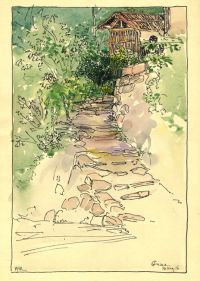Introduction
This selection of "unclaimed" art, what Jones and Galison define, in Picturing Science Producing Art (New York, Routledge, 1998), as "images that remain 'unclaimed' by the institutions of art but are readable as constructions of visual knowledge," resides in the Hunt Institute Archives. These works testify to the ease with which scholarly work overflows disciplinary boundaries and point to the commonalities in the practices that produce both art and science. This scientific documentation ponders the boundaries of art and the intersections of science and art.
Academics have discussed science and art as far back as C. P. Snow's 1959 theory that science and art constituted "two cultures" that were unequal—with science progressive, superior. In 1962 Thomas Kuhn claimed science and art were both products of human behavior and thus subject to the "paradigm shifts" of historical change, but he maintained that illustrations were mere byproducts of scientific practices, while they were the very goals of artistic practices. Later, Ernst Gombrich tried to apply scientific criteria of realism to art, and Erwin Panofsky showed how the artistic convention of chiaroscuro enabled Galileo's interpretation of moon craters. This exhibit encourages thinking about these issues and suggests that disciplinary definitions can shape an image's interpretation. This exhibit suggests that disciplinarity constricts research, inviting scholars in science history, Latin American studies, gender studies, or art history to think creatively about the resources around them. This exhibit hung on the fourth floor of the Hunt Library on the Carnegie Mellon campus, from 19 November 2001 to 28 February 2002. It was curated by Angela Todd (archivist, 2000–2013) and designed by Lisa Ferrugia (archival assistant, 2000–2003).
Frederick Wilson and Dorothy Popenoe
Frederick Wilson and Dorothy Popenoe were one of many couples working together in botany. Agricultural explorer F. Wilson Popenoe (1892–1975) established the Escuela Agricola Panamericana in Honduras on behalf of the United Fruit Company in 1943. The school's goal was to teach native growers to improve their techniques and crop yields. Dorothy Popenoe (1899–1932) was a botanist, illustrator and archaeologist whose drawings complemented Wilson's published works on Central American fruits and typified the style that scientific illustration connotes. The works in this exhibit are visual records of the circumstances that constituted them. Global economics and American consumption of "exotic" foods (avocadoes, bananas, mangoes) shaped Wilson Popenoe's photos of native residents and Dorothy Popenoe's fruit drawings. Learn more
Benjamin Yoe Morrison
Benjamin Yoe Morrison (1891–1966) was principal horticulturalist and head of the Division of Plant Exploration and Introduction at the United States Department of Agriculture (USDA) and later director of the United States National Arboretum. His collection of sketches and ink drawings of Asia date back to the nineteenteens. These works are part of the Archives due solely to the encouragement of his secretary, May Blaine (1889–1973). In a letter to Blaine, Morrison wrote: "You will be relieved to know that I have sent your Doctor Lawrence [George H. M. Lawrence, Hunt Botanical Library Director, 1960–1970] whatever drawings I had....While I understand his job and the necessities of it, I personally do not care one iota if I am never remembered at all anywhere by anyone. I have told Lawrence that and, while he says that he respects my point of view, he says I can not escape." Morrison's amazing drawings were made possible by the prestige of an ivy league education and the generosity of academic donors; they were saved by the efforts of the Division's bright and forward-thinking secretary. Learn more
Walter Henricks Hodge
With his wife Barbara Taylor "Bobbie" Hodge (1913–2009) sharing his laborious but rewarding fieldwork, Walter Henricks Hodge (1912–2013) catalogued the flora of Dominica, West Indies, which earned him a Ph.D. from Harvard in 1941. Hodge's photographic collection traced the couple's travels through Dominica and beyond. World War II's increased incidence of malaria to our military and the search for non-Asian alternatives to the antimalarial quinine took the Hodges to Peru. Dr. Hodge signed on with the U.S. Office of Economic Warfare's Cinchona Mission in 1942 while Bobbie worked at the American embassy in Peru. Global politics and fighting in the climates of disease dictated Hodge's travels, his focus on the plant genus Cinchona Linnaeus from which quinine was derived and his time in the high elevations of their woody environs. A tireless portrait photographer, Hodge's riveting landscape photos were nonetheless the inspiration for this exhibit. Learn more

Arima, Japan, 26 May 1916, watercolor by Benjamin Yoe Morrison, HI Archives Benjamin Yoe Morrison collection no. 27.